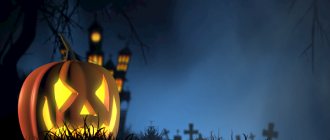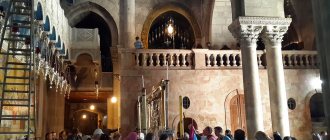What did the Celts celebrate on October 31?
The history of the Halloween holiday is a vivid example of the struggle between Darkness and Light, Evil and Good. It originates from the Celtic tribes of England, Ireland and northern France (Gaul), from pagan times.
On the night of October 31, the Celts celebrated Samhain - the beginning of the new year. On this day there were no boundaries between the earthly and otherworldly worlds: the gods calmly entered human life. But all these deities had a bad character: they were cruel, they always opposed each other and fought. People had only one option to temporarily pay off: make a sacrifice.
Celtic priests - Druids - extinguished light in all its manifestations (bonfires, lamps). In the evening of the next day, they kindled a huge fire, on which they made sacrifices to Samhain, the god of death and darkness. To be honest, to Satan as the prince of darkness.
If Samhain remains satisfied, then the dead will be able to visit the living - the Celts believed. In addition, it was believed that the souls of the deceased were terribly hungry. They had to be fed, otherwise the god of death would be angry and would definitely punish the people. Therefore, they prepared all kinds of treats.
Do you see any parallels with modern Halloween celebrations?
- People dress up as ghosts, witches and various spirits, symbolizing the souls of the departed.
- They wander around all night.
- Begging for sweets (trick-or-treating) - it is no coincidence that this expression is literally translated as “trouble or treat.” The seemingly harmless treat for children actually originates in the propitiation of the hungry souls of deceased relatives.
How to tell fortunes for Halloween?
On the night before Halloween, you can tell fortunes. These fortune tellings are very similar to fortune telling on the night before Christmas. Unmarried girls tell fortunes about their betrothed, married girls find out how many children they will have. Let's list some of the most popular fortune telling.
Unmarried girls can see their future husband on Halloween night. To do this, they need to wash their nightgown late in the evening and hang it on the back of a chair to dry. Then the girl must go to bed in the room where the shirt is drying, but she cannot fall asleep. The fortuneteller should see the appearance of her future husband, who will come to pick up the shirt. If the girl did not wait for the shadow of her betrothed to appear, it means that a wedding should not be expected in the next three years.
If the girl already has a spouse, then on Halloween you can find out how many children there will be in the family. To do this, take a small plate, pour cold water into it, and then drop some egg white into it. How many parts the protein divides into - how many babies will be born.
You can tell fortunes about the events of next year. It is necessary to prepare in advance a coin, a ring, a button, a heart cut out of red paper, a shell and a key. You will also need an empty bottle. Fortune tellers must arrange all objects in a circle. The bottle must be placed in the center of the circle and twisted clockwise. When the bottle stops, you need to look where its neck points, this will be the main event of the year: ring - wedding, coin - wealth, button - lack of love, loneliness, heart - love, shell - travel, key - success, power.
The Church's attitude to Halloween, or Between the Feast of Darkness and All Saints' Day
But how could the bright feast of all saints, celebrated by the Western Church, fit in with such a day of darkness, death and fear? This is due to the arrival of Christianity in Ireland. The most important role in this was played by the well-known Saint Patrick.
On Beltane, celebrated on May 1, it was forbidden to light a fire until the Druids had prepared a pyre for burning sacrifices. But Saint Patrick disobeyed and lit a fire, which symbolized the Divine Light. It was he who resisted darkness, fear and death.
In just six months, Ireland has changed a lot. And where fear had previously reigned, love was now preached. The holiday, which was previously associated with fear and death, became All Saints' Day, which stopped the forces of Samhain and the spirits of darkness.
And already in the 9th century, Pope Gregory IV declared this holiday common to all Catholics. Even the name Halloween itself is a shortened version of All Hallows' Eve - the eve of all saints.
Why is he scary?
Ancient fertility festivals were often accompanied by sacrifices. And also – unbridled behavior. The same Romans collected the grape harvest, pressed new wine from it - and the village went for a walk... It’s terrible what it came to!
But most importantly, these holidays were a meeting of life and death. After all, nature that “falls asleep” “dies.” What if next spring doesn't come? What if we eat our fill for the last time?..
So we had to either appease or, conversely, scare away all sorts of evil spirits who are just waiting to harm a person...
That’s why the New Year was “overgrown” with all sorts of sinister characters like Krampus and Joulupukki... Why Krampus! Our beloved Grandfather Frost was also considered an evil spirit in Rus'. It is not for nothing that his name contains the root “mor” - “death”.
I love in deep graves
Dressing the dead in frost,
And freeze the blood in my veins,
And the brain in my head is freezing.
(This is how he talks about himself in Nekrasov’s poem “Frost, Red Nose.”)
Scientists consider our Frost to be one of the incarnations of the East Slavic pagan deity Veles - a werewolf, a man-wolf, who had to be appeased with kutya (festive sweet porridge), gifts and carols.
Therefore, it was not Santa Claus who gave gifts to children for the New Year, but Saint Nicholas (whose day is celebrated on Christmas Eve).
But Nicholas is a Christian saint. And who will congratulate Tatar children (they are Muslims) or, for example, Kalmyk and Buryat children (they are Buddhists)? Not to mention atheists who don’t believe in any saints at all...
So they came up with the idea in our country in 1935: let Santa Claus give gifts to all children, but not the evil one, but the good one.
Exactly 1935 is the year of birth of our Grandfather Frost. Quite young, by historical standards!
Our Father Frost is accompanied everywhere by his cheerful and kind granddaughter, Snegurochka. And in other countries? Let's try to tell you about the most unusual companions of Santa Claus, but you decide for yourself who you like best...
Why is Halloween dangerous?
The modern celebration of October 31 is a return to pagan roots. Under the seemingly bright and memorable fun, creepy things are actually hidden. To be completely frank, satanic. Why?
Firstly, their participants are usually teenagers and young people who:
- often do not have a strong opinion of their own and are easily influenced by authorities and the mood of the masses;
- want to stand out from others;
- active, want to try everything;
- entered a period of increased sinfulness.
They simply do not understand where the danger lies.
Secondly, the very inheritance of dark forces is dangerous for a person. This is why the Church’s attitude towards Halloween is negative.
Surely you have heard the stories of actors who played the roles of dark forces or people stuck in some kind of sin. When you try to portray this, you yourself unwittingly inherit such habits.
What will happen if a young girl dresses up in a witch costume, starts laughing loudly, and attracts the attention of guys with her indecent behavior? Or will the young man dress up as some kind of evil spirit? After all, it’s not enough to just try on a costume, you also need to somehow get used to the role for the best effect, so that all my friends understand how it suits me!
All events influence a person in one way or another. Nothing goes unnoticed. Unfortunately, so is the wild celebration of Halloween, the costumes, the acting and the general mood.
Often such parties can end in alcohol intoxication and fornication. It could be even worse. For some time in America, young people even began to engage in hooliganism, for example, breaking glass. To stop this, the Boy Scouts came up with a movement with the slogan “Sane Halloween!”
In Sweden, more than 200 schoolchildren who celebrated October 31 were injured due to a building fire.
Not long ago, the American Church of Satan decided to “promote itself” by calling this holiday “its own.” No one considered this a threat, but after such facts, can the negative attitude of the Church towards Halloween change?
I wouldn’t specifically like to contrast our culture with the American one and say that other people’s holidays have come to us and are imposing something on us. We choose whether to accept it or not.
I would like to focus on something else - on the distortion of the understanding of good and evil. The Halloween holiday, along with ghoul costumes, tomato juice instead of blood, minor manifestations of violence (supposedly “for fun”), and cookies in the form of coffins and skulls, already has a negative impact on the child. It begins to seem to him that all this is normal and even good.
Child psychologists, psychotherapists, and priests are faced with various consequences: neuroses, nightmares, constant fears, fear of being alone.
There are even stories where such an “innocent” dressing up as evil spirits could lead to demonic possession, when a person was actually possessed by an evil spirit. A man once decided “for fun” to depict the action of evil, and got into the mud. For some, it’s easy to clean it, but for others, even expensive stain removers and dry cleaners won’t help. Therefore, it is better not to get dirty in the first place.
Snow Maiden in Finnish. Goat
In Finland, children call Santa Claus with the funny word “Joulupukki”. Modern Joulupukki looks like the most ordinary Santa - a kind grandfather in a red fur coat, with a white beard and gifts in a bag. Only for some reason accompanied by a goat. Why?
And the thing is that the word “joulu” in Finnish means “Yule”, that is, “Christmas”, and “pukki” means... “goat”! Yes, believe it or not, but in Finland one of the traditional ancient symbols of Christmas and New Year is a goat, and not just a goat, but a werewolf goat!
Moreover, not so long ago this same goat came to the children’s house on a festive night - on old postcards and pictures from Finnish books you can see a tall man with the head of a goat or with goat horns. In one hand he holds a bag of gifts for those who behaved well; in another - rods for punishing naughty Finnish children. And old Joulupukki put the most notorious lazy people and unhearing people into a bag, took them to Lapland, where he boiled them in a cauldron and ate them, that’s right!
In the modern tradition, of course, this character has become kinder and “divided.” Separately, there remained the good Santa Claus, and separately - just a goat, Santa’s indispensable companion...
Who benefits from mass madness?
Who benefits from the modern Halloween holiday as a return to paganism? You can answer in one word: the devil. And he acts through people.
On the one hand, it tempts young people, partially corrupts them, provokes them into indecent behavior, fornication and debauchery. Of course, a lot depends on the company. For some, Halloween will turn into a fun party, with pumpkins, costumes and a good mood - everything seems to be decent. And for others it is a night of testing with all sorts of vices.
On the other hand, the evil one also tempts the organizers of such events, people who set unrealistic prices for witch and vampire costumes. For example, this year Americans plan to spend $6.9 billion on celebrations and costumes. By the way, about the latter.
The evil one still has one way to search for people - to pull the hook of envy and pride. Like, your neighbor has such an expensive suit, but what about you? Can't you buy yourself something just as good? Or even better? You should look more worthy than everyone else! And how much easier it is if you don’t participate in all this.
Snow Maiden in German. Devil with horns
Let's move to Germany. The local companion of Santa Claus is called Krampus, and he looks simply creepy - a black demon with glowing eyes, a long tongue, a tail and goat horns.
Krampus holds a bag and a whip (or a bunch of rods) in his hands. In this case, we can observe the classic “division of labor” - Santa Claus gives gifts from his bag to good and obedient children, and Krampus puts bad and naughty children in a bag and punishes them with a whip.
Wow New Year, right? You’ll come to your Christmas tree to do round dances, and then they’ll remember that you got a D in math and didn’t tell your parents - and not only will they not give you any gift, but they’ll put you in a sack, and even flog you!
Look at the German Christmas cards published in the last century - have you already understood how happy the boy is that such a cheerful and cheerful “Snow Maiden” came to visit him?
We are looking for alternatives
If the school is planning a costume party and you understand that participation in it will only make things worse for your child, talk to the class teacher and think about an alternative.
Children want a holiday - so arrange it for them in the family circle. Let mom bake a pie, let the children help her with this, and dad try to come home early from work. You can spend this time together, slowly talk about school, plans for the summer, books, ideas for traveling together and... the history of Halloween.
You can even get together with other families who do not approve of modern Halloween symbols and have your own holiday. Bright and kind. After all, it was precisely the victory over darkness that he symbolized when it became All Saints’ Day in the Western Church.
Snow Maiden in Italian. Witch
Attention, Italian Snow Maiden! Her name is Epiphania, or, locally, Befana. By the way, among Italian children Befana's popularity has long surpassed Babbo Natale himself (that is, in Russian, Father Frost).
This is the most real, one might even say “classic”, witch. An elderly, but not yet quite old, good-natured woman, wears a pointed hat and flies on a broomstick. All year round she does the usual witch things, and on New Year's Eve she grabs a bag of toys on her back, sits on a broom and climbs into houses through the chimneys. For Befana, Italian children hang stockings on the fireplace, in which she places gifts.
However, Befana only gives gifts to obedient children! If the child did not behave very well and was lazy, Befana puts a piece of coal in his stocking. By the way, the writer Gianni Rodari portrayed the extremely unsympathetic Befana in the book “The Journey of the Blue Arrow” - in it Befana has become modernized, left witch things in the past and works as the mistress of a large toy store. Only she delivers toys to children not for free, but only for money.
Snow Maiden!
In fact, every joke has a grain of humor in it. All the traditional New Year and Christmas characters described above are folklore heroes who are an integral part of the culture of their country. What seems bizarre, ugly or sinister to us, for others, on the contrary, is just a fun game and celebration. You should see German children running away laughing in different directions from the tailed Krampus with a whip (not a real one, but, of course, an actor)... In general, tradition is tradition. But anyway…
Whatever you want, for some reason we like our Snow Maiden the most!
Source
In which countries of the world is Halloween celebrated and how is it celebrated?
Although the Halloween holiday has common traditions, it has its own characteristics in different countries. It gained quite a following in Western Europe and America.
At the end of the 20th century, its traditions moved to the CIS and Eastern Europe. Also celebrated in Japan, Australia, South Korea, New Zealand, Singapore and Oceania.
How Halloween is celebrated in Russia
Halloween came to Russia in the nineties and remains an exotic holiday to this day. It is not celebrated as widely as in other countries.
For our compatriots, this is, first of all, a reason to hold a fun masquerade party, dressed up in mystical costumes.
The holiday is mainly loved for its surroundings and is spent in entertainment venues.
The clubs hold special Halloween parties. And at home, adults create scary but fun Halloween riddles for children.
There are also many who organize small home parties. They decorate their homes with themed paraphernalia, create dishes and various crafts for Halloween.
It is worth saying that the attitude towards the holiday in Russia is ambiguous. There are many opponents
.
They believe that these are foreign traditions that are being imposed from Europe and America. Moreover, they carry only darkness within them.
Halloween is usually held in the form of a carnival procession dressed as dark creatures. All this is alien to the Russian people. We rarely have carnivals themselves. Especially with the worship of evil spirits.
Therefore, in Russia there are many opponents of this holiday. And both among politicians and among ordinary citizens.
According to polls, only one person out of twenty plans to celebrate this holiday. Mostly these are young people.
Government officials are trying to ban Halloween celebrations in schools and other educational institutions.
But some people went even further!
Believers sometimes conduct Orthodox raids on clubs at this time. In case of violation of public morals, comments are made. And sometimes they even call the police.
However, despite this, Halloween has its own significance in Russia, although not great. This is just another reason to relax. But given our mentality, some traditions are categorically not suitable for us.
For example, no one will send their dressed-up child to go to other people's houses and beg for sweets. Because this will be fraught with serious consequences.
However, if you think about it, Halloween has something in common with the Slavs and our Russian traditions.
For example, it is believed that on Christmastide
Spirits and all kinds of evil spirits walk the earth. During these days, our ancestors practiced fortune telling so that the spirits could tell them the future.
On the day of Mokosh
led two-ring round dances.
And they jumped over the fire on Ivan Kupala
.
Mexico
In Mexico, they focus more on the Santa Muerte
(
Holy Death
). It is celebrated on November 1st and 2nd. Mainly death. She is depicted as a skeleton in white clothes.
Santa Muerte
Mexicans place food and drinks on their home altar to appease their deceased relatives.
The graves are decorated with flowers and ribbons. A bottle of alcohol is placed at the graves of adults, and toys for children.
What Halloween looks like in America
Halloween in the USA is one of the most beloved holidays. According to tradition, Americans prepare for it in advance by decorating their homes with pumpkins, skeletons and creepy figures.
Procession in New York
A lot of themed cards, costumes and souvenirs appear in stores. And children dressed as zombies go from house to house begging for treats.
Often adults and young people like to scare children with scary pranks ( gags
) and Halloween stories. Everyone congratulates each other on the holiday.
Celebrations may vary depending on the region. Somewhere the holiday is considered a family holiday. And somewhere there is a reason to throw a party for adults only.
New Yorkers organize processions of ghouls and hold themed events in zoos and museums.
Los Angeles celebrates Day of the Dead with a focus on Mexican heritage. And in Boston on this day people visit haunted houses, various performances and even tours of cemeteries.
Makes for a pretty fun Halloween.
What do people do for Halloween in the UK?
In the UK, the main place of celebration is London with its dark past and slightly eerie atmosphere. The memory of the famous serial killer Jack the Ripper
.
Scary Halloween is accompanied by visits to a number of mysterious places and numerous events. Old castles receive a lot of attention.
Oxfordshire has become very popular
.
For several years now, its visitors have been rapidly hunting for the ghost of an eight-year-old boy. There is a legend that at this time he appears at the hotel. He died with his mother in 1768.
Residents and guests of the city are offered a lot of entertainment. These include scary tours, themed dinners and parties, colorful parades and much more.
There are even separate seances
. People spend their money on them to communicate with deceased relatives. Therefore, the night before Halloween is quite interesting here.
The main color of the holiday is orange. Therefore, many establishments decorate their premises and serve dishes in orange.
Celebrating Halloween in Germany
In Germany, both old and new customs are observed. There is a tradition on Halloween night to hide knives so that the visiting souls of the deceased cannot cause harm.
Halloween Party at Frankenstein's Castle
Local youth dress up in costumes and attend parties in bars and clubs.
Bavaria celebrates a pumpkin festival
and themed tours of
Frankenstein's Castle
.
People are sure that here you can meet the ghost of the castle owner.
In their houses, residents place a scarecrow in front of the front door. The houses themselves are decorated with colorful garlands.
They also use a pumpkin for the Jack-O-Lantern. However, the pulp itself is not thrown away. It is used to make sweets.










